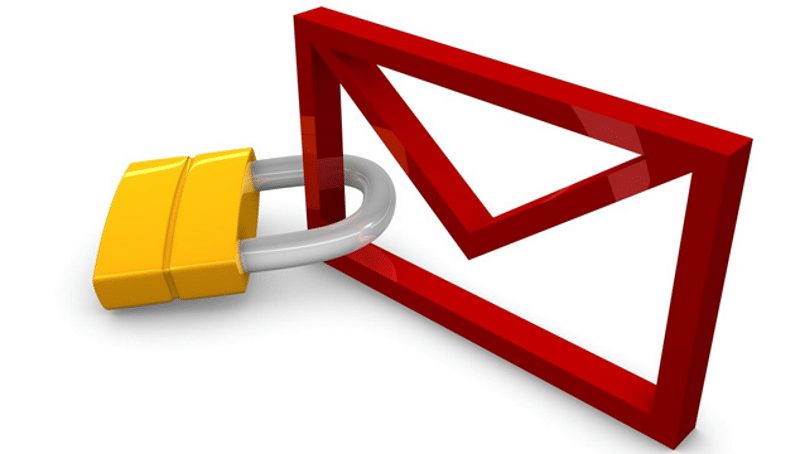How to encrypt emails
Have you just been invited to a party? She knows it. Did your classmates tell you a list of fun videos to watch? She has already seen them all. Whatever you spend in your email box falls into the clutches of your beloved little sister, and the situation is repeated on time even at the home of your friends. Now it is clear, if you want to communicate via email while maintaining privacy, you must How to encrypt emails.
Do not worry. I am not going to offer either very complicated security software or very long secret agent procedures. If you want to succeed in the enterprise, all you have to do is resort to the use of some special services, usable directly from the browser, as an extension and / or in the form of app for mobile devices, which, while allowing you to perform an operation as articulated as the one in question, turn out to be very easy to use even by those who, a bit like you, has never considered a “freak”. In this way, you can encrypt (and decrypt, if necessary) the e-mail messages you send in a flash.
Then? What would you say to put the talk aside and move on to the actual action? Yes? Great. So I suggest not to waste any more time and start to get busy. Position yourself so comfortable in front of your credit card and read with the utmost attention all the information I am about to provide you. I am sure that in the end you will be able to tell you very happy and satisfied with what you have learned and that even at the first good opportunity you will be ready to provide useful advice to all of your friends. Enjoy the reading!
How to encrypt emails – ProtonMail (Web / Android / iOS)
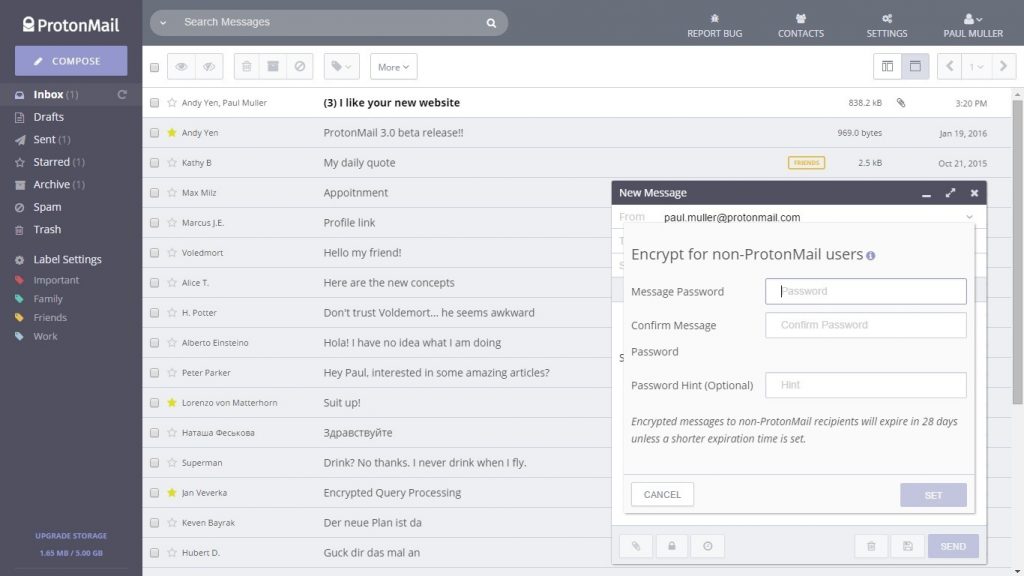
How to encrypt emails
The first resource I want to recommend you try to encrypt email is called ProtonMail. It is one of the most popular services for the purpose in the world. It’s free (but it is also available in two paid versions with extra features) and to use it you must register in order to create a special account from which to send the mail in a secure and secure.
Emails sent between users using the same service are automatically encrypted and decrypted. If, on the other hand, the message is sent to a “normal” email address, a secret question can be used, to which the recipient must reply in order to read the message.
To serve, first connect to the main page of the service and then press the button Create your email account encrypted on the left, select the Free plan and click on the Select free plan button in the menu that appears.
Fill in the form that is proposed to you by typing in your username and selecting the domain name you want to use, choosing a password (and confirming it) and providing a recovery email to use an emergency case and then click on Create account.
Now, check the box next to the entry I am not a robot, select the required images and click on Check first and then on Complete the configuration. So choose which name you want others to see when you send an email and click on Finish.
At this point, you can finally tell yourself satisfied: you’ve just managed to create your e-mail account to send encrypted emails. To send a message, presses then on the Compose button at the top left, type the recipient and subject of the email in the appropriate fields attached to the window you see appears and enter your text in the space below and then attach any files after clicking on the button with the paper clip presses the button with the lock to encrypt the mail.
Then choose the password you want to use to encrypt the message twice in a row, filling out the appropriate fields, enter a suggestion and presses on Tax. If you want, you can also make sure that the message is destroyed once a certain amount of time has elapsed. To do that, presses the button with the hourglass and specifies when you want to expire the message and then press Set.
To conclude and then to send the encrypted email, press the Send button. Done! Who will receive the message can read it only by typing the password set by clicking on the View Secure Messagg button. If instead, as anticipated at the beginning, the recipient in turn uses ProtonMail, can read the email directly.
If you are interested in it, I also point out that the service can be used in the form of apps for Android and iOS. The operation is good or bad the same of the site.
How to encrypt emails – Sbwave Enkryptor (Web)

How to encrypt emails
If you do not like the idea of creating a new e-mail account specific for the purpose in question but you still need to crack emails, you can contact Sbwave Enkryptor, a free service to encrypt text messages to be sent via e-mail.
Using it, the recipient receives the message illegible if he does not have the appropriate password that you can set when sending. It’s free, you do not have to register and you do not have to download anything on your PC. In addition, the service site does not contain advertisements. Too bad it does not support sending attachments.
To use it, connect to the Sbwave Enkryptor website and fill in the fields at the top left by typing the recipient’s e-mail address next to To email :, your name and your e-mail address next to the fields Your Name: e Your email: and the subject of the message next to Subject :.
Then check that the box next to the word I have read and agree to all conditions. is selected (and if not you do it) then type in the password you wish to protect the message in the field next to the Encryption Code: and write the text of the email under the Message: entry.
Finally, click on the Encrypt & Send button and the encrypted message will finally be sent. The receiver can read it only by typing the password chosen during the dialing phase.
How to encrypt emails – Lockbin (Web)
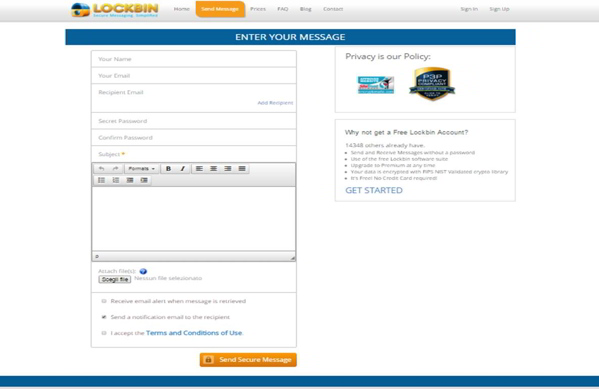
How to encrypt emails
Similarly to the above service, Lockbin, the service I’m about to talk to you, allows you to encrypt emails without having to create a special account by force, in a free and surprisingly simple way.
If desired, it can also be used upon creation of an ad hoc e-mail address (also available as a paid variant with extra functions) that allows all correspondence to be handled but is not an obligatory step, especially if the encrypted messages to be sent They are few.
Do you wonder how to use it? I’ll explain it to you immediately. For starters, connected to the web page of the service dedicated to sending e-mails without encryption, then enter your e-mail address in the Your Email field, the recipient’s in the Recipient Email field and the subject of the message in the Subject field.
Then type the text of your message in the field in the center, if you need to attach files click on the appropriate button located under the Atach file (s) and select them from your computer then choose whether or not to receive a message notice when the email is received and check the box next to the words I accept the Terms and Conditions of Use. to accept the conditions of use of the service and then click on the Send Secure Message button. Done!
The recipient will then receive an email whose content can be read only and exclusively after clicking on the appropriate button inside and suasivamente to enter the password chosen to encrypt everything.
How to encrypt emails – Infoencrypt (Web)
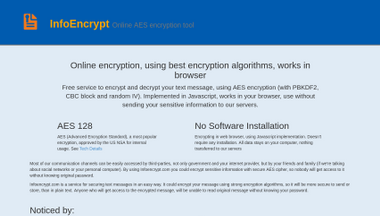
How to encrypt emails
The services above have not convinced you in a particular way and you look for an alternative alternative to encrypt emails? So I suggest you try out Infoencrypt, a free and web-based resource for sending password-protected messages.
It does not allow sending e-mails directly but provides a link that can be sent via any e-mail account to allow the recipient to read the encrypted message without typing in the password.
To use Infoencrypt, first of all you need to connect to the service home page and then type your text in the appropriate box under Text to encrypt (or encrypted code to decrypt) :, enter the password with which you want to protect the message under the heading Password and retype, for confirmation, in the adjacent Confirm Password field.
Now, click on the Encrypt button on the right and then press the Link to Encrypted button and the Yes button, save and give me a link and then copy the link provided.
Now, start the composition of a new email using the service that you usually use and paste in it the link copied previously. Then send the e-mail message.
Who will receive the email, can read the encrypted message by clicking on the link and entering the password you have chosen when composing.
Note that the link will be accessible for 90 days, after which it will be removed from the service servers. Despite this, the whole encryption operation is performed on the client side, in the browser, and therefore Infoencrypt stores only the encrypted messages, without a password in the following, thus being impossible to read by those who are not authorized.
How to encrypt emails – Mailvelope (Browser extension)
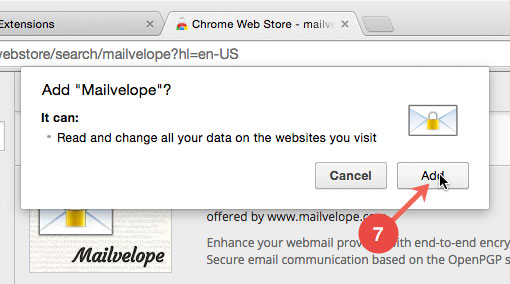
How to encrypt emails
To close in beautiful, as they say, I want to talk to you instead of Mailvelpe, a free service to encrypt emails sent with Gmail, Outlook, Yahoo and all other major e-mail services.
Using it is very simple as it is enough to install a special extension for Chrome and Firefox that makes the encryption automatic for each message sent. The only thing to be taken into account is that in order to read the messages sent the recipient will have in turn install the extension.
To use it, if the browser you are browsing on the network is Chrome, connected to the appropriate section of the Chrome Web Store, presses the Add button and then on Added extension and wait a few moments for the installation to start and complete. If you are using Mozilla Firefox, visit the appropriate section of the browser add-ons gallery, press the Add to Firefox button and then click Install.
Now, click on the Mailvelope icon (the padlock) that has been added to the browser toolbar and presses on the gear icon in the menu that opens. Then click on the button Generate key and then fill the fields on the screen by typing the name of the person you want to send the mail, its e-mail address and the password you want to use to encrypt the messages to send then click on the button Generate that is down.
Once this is done, a message with the key will be sent to the e-mail address you just set in the extension settings to decrypt the e-mail that you are going to send. The key must be imported into Mailvlope by accessing the Import Key section of the extension settings, by clicking on the Select a key text file to import button and selecting the reference file.
Should there be any problems and the mail should not be received by the recipient, you can send it by hand by clicking on the item Display Keys which is in the left side coffin of the configuration tab of Mailvelope, pressing the reference email address that you find in the list and selecting the Export tab in the window that opens. Pusch then on Public and press Save to save the generated file on your PC. Then proceed to send it to the person you wish to send the encrypted email message to.
Also done this, access the Webmail service that you usually use, start the composition of a new e-mail and click on the button with the sheet and the pencil you see appear in the area dedicated to entering the body of the message and then compiles fields attached to the new window that opens by typing in correspondence of Add recipient the email address of the person you want to write to and below your message.
If you want to attach files to the email, click on the Encrypt files link, click on Add and select the files to send (which must not exceed 50 MB) and then click on Next.
To conclude and then to send your encrypted message, press the Encrypt button at the bottom, type the subject of the message in the appropriate field of the “usual” screen related to your Webmail service and press the button to send the email.
The recipient of the message will then receive the encrypted email and can read it by opening it, clicking on the icon with the envelope for correspondence and the padlock in place of the body of the message, typing in the appropriate field that will appear the password you choose configuration phase of Mailvelope and clicking OK.
How to encrypt emails

